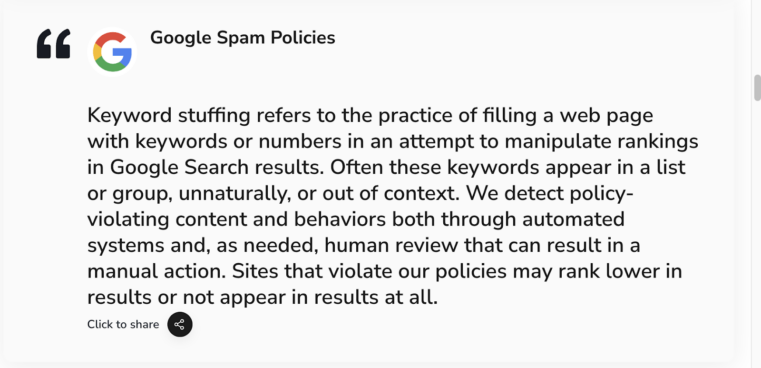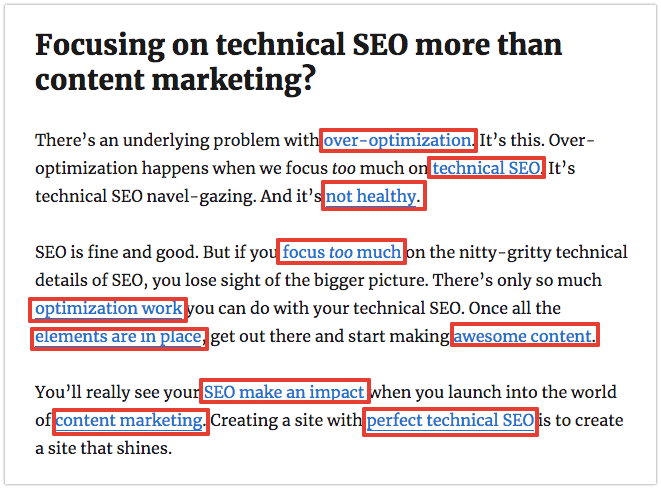Keywords are the cornerstone of any successful search engine optimization (SEO) strategy, but when is too much of a good thing really too much?
Google Search Advocate John Mueller advises against using keyword-rich business domain names. Such domain names are often associated with spam and make it difficult for companies to expand their offerings and build a strong brand identity.
More so than domain names, keyword stuffing or the overuse of keywords in website content has always been frowned upon.
So, is there such a thing as targeting too many keywords? YES.
In this blog, we discuss what is keyword stuffing, how it can hurt SEO performance and the best practices to avoid it.
What Is Keyword Stuffing?
Google officially defines keyword stuffing as overusing keywords on a webpage to manipulate organic search engine rankings. The idea is to make a web page more relevant for specific search terms, which will help the page rank higher.
More on Google’s spam policy:

While some marketers may view it as a shortcut to boost their SERP visibility (search engine result pages), it can quickly backfire and hurt traffic generation and conversions.
According to Don Gruspe, a Demand Generation SEO Specialist at Thrive, keyword stuffing hampers user experience, invites search engine penalties, diminishes content relevance and casts a negative light on brand perception.
Some examples of keywords stuffing include:
• Repeating the same keyword multiple times throughout a webpage.
• Stuffing keywords into hidden elements of the page like business domain names, meta tags or alt attributes.
• Using blocks of text to list cities and regions that a web page is trying to rank for.
• Embedding keywords in the text without using font color to make them invisible.
• Inserting keywords in the page’s code.
This example by Google provides a good illustration of what not to do when it comes to keyword stuffing:

We also have to talk about the excessive use of spammy links, also known as spamdexing. Although spammy links are not a direct keyword-stuffing example, it follows the same principle. You’re trying to fill your content with too many links, which search engines may interpret as keyword stuffing.
Here’s an example of using spammy links:

Is Keyword Stuffing a Ranking Factor?
In the early 2000s, this archaic marketing tactic was one of the only ways websites could successfully rank in search engines. However, as the algorithm became more sophisticated, Google penalized websites that keyword-stuffed their pages.
For instance, Google’s 2011 Panda update devalues low-quality sites and thin content with little or no added value to the user. It also penalized sites with an unnatural use of keywords and prioritized those that produced meaningful content.
And then there’s the 2013 Hummingbird update. This update brought conversational search to Google, meaning users could use natural language in search queries and Google’s algorithm would understand what they were looking for.
This update ultimately marked the shift from content writing for search engines to writing content for people. Keyword stuffing became obsolete as Google’s search algorithm evolved to recognize quality content that provided value to users.
To answer the question: No, keyword stuffing is no longer a ranking factor and attempts to use it can hurt your SEO campaigns and traffic generation efforts.
Ultimately, white hat SEO tactics like creating quality content with relevant keywords naturally integrated into the text are the best way to boost organic search engine rankings. For best results, consider hiring a search engine optimization consultant.
Other Ways Keywords Stuffing Can Hurt SEO Performance
Keyword stuffing in business domain names or website content, in general, is what every search engine marketing expert warns against. Here’s why:
1. It’s Associated With SEO Spam
Keyword-rich business domain names or excessive keyword usage can be considered SEO spam. As mentioned, search engines like Google penalize websites that engage in keyword stuffing and other SEO spam practices.
These penalties range from lower organic search engine rankings to complete removal from search results.
Also, spammy content raises suspicion among readers. This skepticism can lead to losing brand trust and confidence, resulting in potential customers seeking alternative sources.
2. It Results in Poor User Experience
Keyword stuffing compromises the user experience by making the content difficult to comprehend.
When keywords are forcefully inserted without regard for natural language flow, it creates a disjointed and unnatural reading experience for users.
This can lead to higher bounce rates, lower engagement and decreased user satisfaction, ultimately impeding SEO success.
3. It Limits Your Business Focus
A keyword-rich domain name tailored to certain offerings poses difficulties when attempting to change business focus or venture into new offerings.
For example, consider a business under the domain name “top-mobile-phones.com.” While the name suggests a focus on mobile phones, the company might encounter difficulties expanding its offerings to include other electronic devices such as tablets or smartwatches.
How To Avoid Keywords Stuffing
These tried-and-tested white hat SEO tactics can help you to avoid keyword stuffing:
1. Use Keyword Variations
Instead of repeatedly using the same keyword, try switching things up with secondary keywords, long-tail keywords and synonyms.
Long-tail keywords are phrases or strings of words that are specific and descriptive. They allow you to refine your search query and target niche demographics.
Some examples of long-tail keywords might be:
• best running shoes for flat feet
• running shoes with arch support
• cheap running shoes online
You can also use secondary keywords to add context and detail to your primary keyword. Say you were writing content about running shoes. Some examples of secondary keywords could be:
support, cushioning, structure, comfort, style, price and quality
Search engines also recognize that words have multiple meanings, so using synonyms is a great way to add variety to your keywords.
For example, someone searching for “yellow trousers” might also use the phrases “mustard pants,” “lemon slacks” or even “bright khakis.”
2. Maintain Good Keyword Density
Keyword density (KD) is the number of times a phrase appears on a web page compared to the total number of words. While there are debates about whether there is an optimal keyword density, many SEO experts agree that 1-2% is a good number to aim for.
The formula for keyword density is straightforward: Divide the number of times a keyword appears by the total number of words on the page and multiply by 100.
Rather than manually calculating each page’s total word and keyword counts, these KD tools can help streamline the process:
• Semrush On-Page SEO Checker
• Copywritely Keyword Density Checker
• SEOBook Keyword Density Analyze
• SEO Review Tools Keyword Density Checker
3. Expand Word Count
Increasing the word count is a great way to naturally add more keywords without sounding spammy.
For example, if you wrote 500 words on a topic and wanted to add more keywords, try expanding the word count to 800 or even 1,200 words. This allows you to add more keywords without forcing them in every few sentences.
It’s also important to ensure you aren’t just adding words to increase the word count. Your content should remain informative and provide value to the readers.
Consider these best practices when increasing your word count:
• Explaining concepts in more detail
• Providing additional resources
• Adding more examples
4. Focus on Content Quality
Pleasing search engines should not come at the cost of producing low-quality content. Quality, informative content is not only beneficial for SEO rankings, but it also encourages reader engagement and boosts website conversions.
So at what point should you start thinking about keywords?
When you’re in a good flow and content is coming naturally, you can then start to add keywords (where appropriate) without disrupting the quality of your writing.
The same goes for titles, headings and metadata. While keywords can be used in these places to optimize content for search engines, they should still make sense to readers.
5. Happy Optimizing!
Once you have a list of relevant keywords, you can optimize your content by inserting them into strategic places within the text. Make sure to distribute them evenly and organically. The goal here is relevancy rather than repetition.
When you’ve finished optimizing, take a step back and read your content from the perspective of an outside reader. Does it still make sense? Is there too much repetition? Are all the keywords relevant to your topic? Be sure to address these problems before publishing your content.
So, Can You Target Too Many Keywords in Your SEO Campaigns?
Yes, targeting too many keywords in your content can be counterproductive. It’s crucial to maintain a focused and strategic approach to keyword targeting.
While it’s natural to want to cover a wide range of keywords, spreading your efforts too thin can dilute the relevance and effectiveness of your content.
Instead, prioritize a select number of highly relevant keywords that align with your target audience. Remember, quality and relevance should always precede quantity when it comes to keyword targeting.
Thrive’s SEO specialist, Kenneth Romero, advised providing more high-quality content and improving user experience and interface (UX/UI).
“Monitor analytics performance and adjust strategies based on what they need. Clean up any website issues, stay abreast of SEO trends and seek professional help from digital marketing agencies if necessary,” Romero added.
To recap, these white hat SEO best practices will help optimize your website and organically boost SERP visibility:
• Conduct quality keyword research
• Use keyword variations
• Maintain a good keyword density
• Expand word count
• Focus on content quality
Want to get the most out of your SEO campaigns? Partner with a search engine marketing expert like Thrive.
Our search engine optimization consultant will help you identify your website’s best and most relevant keywords. We utilize white hat SEO services, including franchise SEO, content optimization and link building, to help you achieve long-term SEO success.
Contact Thrive today to see how our white hat SEO services can boost your traffic generation and SERP visibility.








